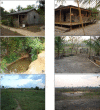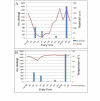Population dynamics, structure and behavior of Anopheles darlingi in a rural settlement in the Amazon rainforest of Acre, Brazil
- PMID: 21702964
- PMCID: PMC3146439
- DOI: 10.1186/1475-2875-10-174
Population dynamics, structure and behavior of Anopheles darlingi in a rural settlement in the Amazon rainforest of Acre, Brazil
Abstract
Background: Anopheles darlingi is the major vector of malaria in South America, and its behavior and distribution has epidemiological importance to biomedical research. In Brazil, An. darlingi is found in the northern area of the Amazon basin, where 99.5% of the disease is reported.
Methods: The study area, known as Ramal do Granada, is a rural settlement inside the Amazon basin in the state of Acre. Population variations and density have been analysed by species behaviour, and molecular analysis has been measured by ND4 mitochondrial gene sequencing.
Results: The results show higher density in collections near a recent settlement, suggesting that a high level of colonization decreases the vector presence. The biting activity showed higher activity at twilight and major numbers of mosquitos in the remaining hours of the night in months of high density. From a sample of 110 individual mosquitoes, 18 different haplotypes were presented with a diversity index of 0.895, which is higher than that found in other Anopheles studies.
Conclusions: An. darlingi depends on forested regions for their larval and adult survival. In months with higher population density, the presence of mosquitoes persisted in the second part of the night, increasing the vector capacity of the species. Despite the intra-population variation in the transition to rainy season, the seasonal distribution of haplotypes shows no change in the structure population of An. darlingi.
Figures





References
-
- WHO. WorldMalariaReport2010. http://www.who.int/malaria/world_malaria_report_2010/worldmalariareport2...
-
- Deane LM. Malaria vectors in Brazil. Mem Inst Oswaldo Cruz. 1986;81(Suppl 2):5–14.
-
- Lourenço-de-Oliveira R, Guimarães AEG, Arlé M, Silva TF, Castro MG, Motta MA, Deane LM. Anopheles species, some of their habits and relation to malaria in endemics areas of rondonia state, amazon region of Brazil. Mem Inst Oswaldo Cruz. 1989;84(4):501–504. doi: 10.1590/S0074-02761989000400008. - DOI - PubMed
-
- Ministério da Saúde. Situação epidemiológica da Malária no Brasil 2008. http://portal.saude.gov.br/portal/arquivos/pdf/folder_malaria_2008_final...
-
- Olano VA, Brochero HL, Sàenz R, Quiñones ML, Molina JA. Mapas preliminares de la distribución de especies de Anopheles vectores de Malaria en Colombia. Inf Quinc Epidemiol. 2001;5:339–46.
Publication types
MeSH terms
Substances
LinkOut - more resources
Full Text Sources

